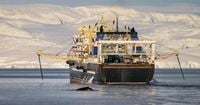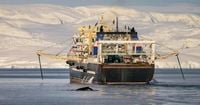Antarctica's krill fishery is on the brink of an unprecedented early closure as the 2024-25 fishing season nears its record catch limit, raising alarm among conservationists and scientists alike. According to a confidential report from the Commission for the Conservation of Antarctic Marine Living Resources (CCAMLR), krill catches have surged to 518,568 tons in the first seven months of the season—about 84% of the 620,000-ton limit that, once reached, will automatically shut down the fishery.
This dramatic uptick in krill harvests follows the collapse of a crucial international conservation agreement last year. The deal, which involved the United States, Russia, China, and over two dozen other governments, aimed to spread out krill fishing areas and establish a California-sized marine reserve along the ecologically sensitive Antarctic Peninsula. However, last-minute proposals by the United Kingdom and Australia for even stricter catch limits led China to withdraw its support, causing the entire plan to fall apart.
"The vast majority of the krill take is from an increasingly smaller area," said Captain Peter Hammarstedt, campaign director for Sea Shepherd Global, which undertook its third expedition to Antarctica in 2025 to document the fishery. He likened the situation to "a hunter saying that they’re only killing 1% of the U.S.’ deer population but leaving out that all of the deer were shot in Rhode Island." This concentrated fishing pressure threatens the delicate balance of the Southern Ocean ecosystem.
Krill, tiny shrimp-like crustaceans, are among the most abundant species on the planet, with an estimated biomass of 63 million metric tons. They play a vital role as a primary food source for whales, seals, penguins, and other marine animals. Their ecological importance extends beyond feeding wildlife; recent scientific studies have highlighted krill's critical role in combating climate change. A peer-reviewed study published last year revealed that krill annually remove and sequester about 20 million tons of carbon from the atmosphere into the ocean—equivalent to taking five million cars off the road each year.
Despite their abundance, krill populations face mounting pressures. Advances in industrial fishing technology, climate change impacts on ocean conditions, and growing global demand for krill-derived products—such as Omega-3 rich oils used in fishmeal, pet food, and human supplements—have intensified harvesting efforts. In the 2023-24 season, a fleet of 12 industrial trawlers, predominantly from Norway and China, caught 498,350 tons of krill, marking the largest harvest since CCAMLR began collecting data in 1973.
Journalists from The Associated Press traveled to Antarctic waters in 2023 and witnessed factory ships trawling dangerously close to whales, whose populations are still recovering from historical industrial whaling that nearly drove them to extinction. Tragically, three humpback whales were found dead or seriously injured last year, entangled in the long, cylindrical nets used to vacuum up krill.
Negotiations for a new management plan have been ongoing for years, seeking to balance the burgeoning krill market with the urgent need to protect the Antarctic Peninsula's vulnerable ecosystems. Currently, less than 5% of the Southern Ocean is protected, falling far short of CCAMLR’s target and the United Nations’ global goal to preserve 30% of the world’s oceans by 2030.
The failure to renew the management system has led to the expiration of restrictions adopted 15 years ago designed to spread out the catch limit. Without these measures, the krill fleet can fish anywhere at any time, including in critical habitats favored by whales, penguins, and seals. Ship tracking data analyzed by Global Fishing Watch, a U.S.-based organization promoting sustainable fishing, shows that trawling activity in one popular fishing ground, Sub-Area 48.1, has more than doubled in the current season compared to the entire previous season.
Javier Arata, executive director of the Association of Responsible Krill Harvesting Companies, whose members account for 95% of Antarctica’s krill catch, emphasized that the lapsed catch limit was always intended as an interim measure. His group supports the creation of marine protected areas but opposes waiting for a protracted conservation deal to implement "ready-to-go measures" that could raise the quota. "The failure to advance management was political, not scientific," Arata said, asserting that current fishing levels, though higher, remain sustainable and reflect the scientific consensus before last year’s negotiations collapsed.
Matts Johansen, CEO of Norway’s Aker BioMarine—the world’s largest supplier of krill-based products—pointed fingers at the United Kingdom’s last-minute proposal during the CCAMLR meeting in 2024. Speaking at the United Nations Oceans conference in June 2025, he said, "Just a couple days before the vote, the UK threw another suggestion and that’s when the Chinese backed off." The UK Foreign Office, however, rejected this characterization, affirming its continued commitment to a krill management strategy that safeguards Antarctic marine species and vulnerable ecosystems.
The stakes are high. Krill are not just another fishery commodity; they are a linchpin in the Antarctic food web and a natural ally in the fight against climate change. The looming early closure of the krill fishery would mark an unprecedented moment in Antarctic conservation history, underscoring the urgent need for international cooperation in managing this critical resource.
As the 2024-25 season progresses, all eyes turn to whether the 620,000-ton catch limit will be reached, forcing a shutdown of the fishery. The outcome will have profound implications for the future of Antarctic marine life, the global climate, and the fishing industry itself.





